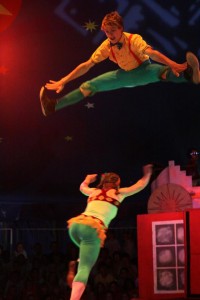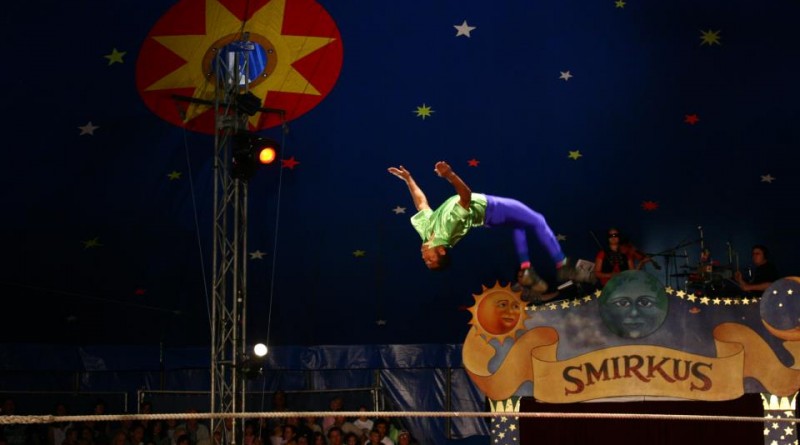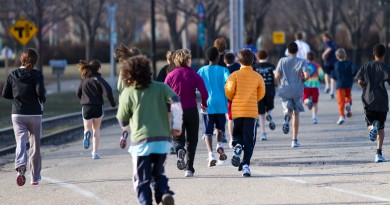The Athleticism of Circus Performing | 18 & Under April 2013
 It’s early June and 30 kids — ages 10 to 18, from all corners of the world — are tumbling, somersaulting, and juggling their way to Greensboro, Vermont, to create a once-in-a-lifetime show.
It’s early June and 30 kids — ages 10 to 18, from all corners of the world — are tumbling, somersaulting, and juggling their way to Greensboro, Vermont, to create a once-in-a-lifetime show.
But these aren’t your average adolescents; they are circus performers, all trained in the arts of gymnastics, juggling, acrobatics, and clowning. Circus Smirkus, founded in 1987 by Rob Mermin, began as a small spectacle, putting on a few shows around Vermont each summer. Today, Smirkus is a full-scale extravaganza, enchanting and enthralling its audiences throughout New England.
While circus arts are not considered traditional sports, the Smirkus troupers’ athleticism and training are undervalued and easily compare with the workload of Olympic athletes. Each day, the troupers travel, unload the circus gear, set up, warm up, train, perform two shows, and then pack up the ring before moving onto the next site. Thanks to their fabulous cooks, they feast on three hearty meals a day, starting with an 8 a.m. breakfast and occasionally ending with the late-night taco feast.
Montpelier High School senior Noah Nielsen and freshman Isa Ansari lived the lives of Smirkus troupers last summer. Noah, 18 and a Montpelier local, has been with Smirkus for four years. Isa, 14, from Oakland, California, fell in love with Smirkus as a little girl while visiting her grandmother in Greensboro. Both Smirkos (a title for anyone who takes part in the Circus Smirkus adventure) agree that the athleticism of the troupers is critical to surviving the grueling schedule.
“At Circus Smirkus, physical conditioning is a crucial aspect to our training. With only three weeks to put together a professional touring show, of which a cast of 30 youth will perform 70 times over the course of seven weeks, there is a very high physical demand on the body,” Nielsen explains. So how and when do these kids get in shape? Nielson says training “is different from one person to the next. But I personally train Crossfit at the Confluence (a fitness center) to stay in shape.”
The Smirkus audition process begins in the fall and continues through midwinter. Upon being accepted, Smirkos receive a circus package that includes information about the required skills to be a Smirko and how to prepare for training in June. “If you aren’t prepared and haven’t been working on the basics, you are going to have a really difficult time getting into the shape your coaches want you in.” Ansari says. “The first couple days of training are very rigorous, and I was so sore, my legs were dead. For aerialists and acrobats, it’s especially difficult because you are holding your own weight all the time. On top of that, we are running around, tumbling, dancing, carrying props, setting up the circus tent. So get a good sleep!”
The turbulent three weeks of rehearsals and training leading up to the first show are scheduled much like a school day: a 7 a.m. wake-up call followed by breakfast, warmups, and acrobatics. Then all Smirkos go with their coaches to work on their respective acts until dinnertime. At the end of those long summer days, the cast finishes their chores and head to the “rickety old hay barn,” as Nielson describes it, for a 7:15 p.m. council meeting, where the entire Smirkus entourage shares and discusses the progress of the tour.
In the midst of the seven-week Smirkus tour, there is limited time for training. “The show itself is training. With two shows a day, plus setup and warm-ups, you have to be really motivated to spend downtime training,” Ansari says. While on tour, a select few coaches travel with Smirkus, helping to pace the Smirkos during their performances and guiding them in warm-ups and behind-the-scenes work.
Founder Rob Mermin believes “circus artists are underappreciated athletes. Most athletes are focused on one area: a pole-vaulter is only a vaulter, but a circus athlete is trained to have an all-around expertise and knowledge of athletics in the circus. At Smirkus, we train the kids to not be too specialized, but to be well-rounded athletes. Therefore, they are prepared for foreign circuses and can fill in for any act.”
So the next time you are at the circus, munching popcorn, beguiled by the aerialists, the clowns, and the jugglers, remember you are watching a fantastic illusion. Beneath the makeup, costumes, and elaborate pranks are 30 serious, hard-core athletes.
MORE INFO: If you would like to temporarily run away to the circus for summer camp, learn more about the Smirko audition process, or get performance information, go to smirkus.org or call (802) 533-7443.


